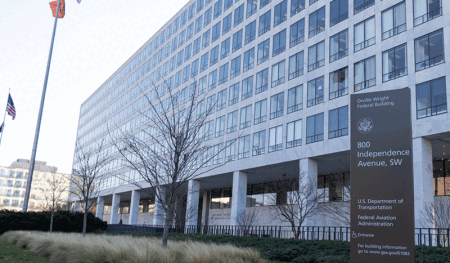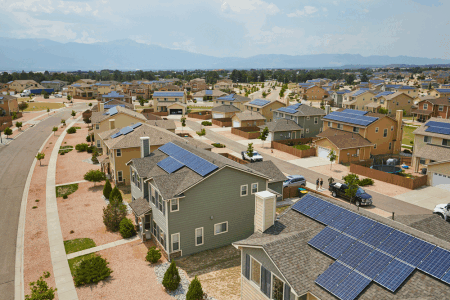Energy performance requirements for federal buildings could propel change across the real estate industry.
The U.S. government is taking a big step toward achieving net zero emissions in all federal buildings by 2045 with initiatives that are also likely to galvanize change across the broader real estate industry.
A handful of new and proposed rules for building standards and codes take aim at reducing energy consumption and electrifying both existing and newly built federal buildings. Because the federal government is the country’s largest owner and occupier of space, the rules will have a sizable impact on both public- and private-sector real estate. The General Services Administration (GSA), which is responsible for overseeing the bulk of federally occupied facilities, manages over 363 million square feet (34 million sq m) of owned and leased space in assets ranging from courthouses and offices to laboratories and ports of entry.
“The goal is to use the federal government as not only a lever, but an example of how this can be done,” says Kevin Kampschroer, chief sustainability officer and director of the GSA’s Office of Federal High-Performance Buildings. The opportunity to affect the federal portfolio is extraordinary, he says. The initiatives are a result of a convergence of factors that include the urgency regarding the effects of climate change, prioritization of sustainability by the Biden administration, and funding made available through the Inflation Reduction Act and the Bipartisan Infrastructure Law.
Such a collective focus by the federal government is expected to result in a huge push to drive decarbonization in the built environment and the real estate industry. If private-sector firms have policies and initiatives in place to comply with requirements when working with the federal government, the impact should trickle down to practices and buildings not involving the GSA, notes Kara Kokernak, senior director of the ULI Randall Lewis Center for Sustainability in Real Estate.
“At a very high level, it’s going to push the real estate industry to report on climate, to address embodied carbon, and hit all of these targets faster than they would prior,” says Kokernak.
Key Highlights
Among the initiatives undertaken on energy efficiency and carbon reduction are the following:
- The Biden administration in December announced the first-ever Federal Building Performance Standard, which sets the ambitious goal of cutting energy use and electrifying equipment and appliances in 30 percent of the building space owned by the federal government by 2030.
- In a complementary move, the U.S. Department of Energy announced a proposed rulemaking to electrify new federal buildings and those buildings undergoing major renovations.
- Beginning in April 2023, all new buildings and major retrofits constructed by the federal government must comply with—and surpass by 30 percent—the 2021 International Energy Conservation Code and the 2019 American Society of Heating, Refrigerating, and Air-Conditioning Engineers Standard 90.1 building energy codes.
A proposed rule now out for public comment would amend the Federal Acquisition Regulation to require that federal contractors disclose their greenhouse gas emissions and climate-related financial risk and set science-based targets to reduce their greenhouse gas emissions. The rule is open for public comment through February.
Moving the Needle on Sustainability
Given the scope of government assets, some heavy lifting is ahead. The GSA will be leaning on asset-level data to prioritize projects: it has data on the energy consumption by type of fuel for every building in its inventory going back more than 30 years. In addition, the GSA conducts an energy audit of every major building in its portfolio every four years. “We will be looking at making the biggest bang for the buck in the places in the country where it makes the most sense and gives us the greatest return,” says Kampschroer.
Specific to the Federal Building Performance Standard, the GSA plans to implement deep energy retrofits through a combination of federal appropriations and by awarding energy savings performance contracts—awarded to private entities and through which the cost of upgrades are paid for by energy savings. The GSA received $3.2 billion in funding from the Bipartisan Infrastructure Law to undertake construction and modernization projects.
According to Kampschroer, the GSA has been looking forward to having a portfolio-level goal like the Federal Building Performance Standard for some time. “Until this order setting out these building standards, everything was building specific. What we have here is an overarching goal,” he says. That portfolio-level standard is very important because it allows flexibility on how and where carbon reductions are achieved, he adds. For example, one building might be able to achieve a 75 percent reduction in carbon emissions, but it might only be feasible for another building to achieve a 25 percent reduction.
Although the new rules and standards take aim at federal facilities, they are expected to create ripple effects through state and local governments, as well as the private sector. For example, more than 30 state and local governments have joined the Biden’s National Building Performance Standard Coalition and committed to reducing the emissions footprint of existing buildings.
Catalyst for Change
The GSA has a long history of driving change in the building industry. For example, the agency was among the first to put motion sensors in buildings to turn off lights back in the 1970s in response to the oil embargo. More recently, the GSA has introduced energy requirements as a part of green leases and required that new buildings and commercial interiors be built to Leadership in Energy and Environmental Design (LEED) standards.
“This is a lot about the federal government taking leadership to show how people can do innovative things in sustainable design to get towards net zero, and also using its clout in the marketplace,” says Bob Peck, a principal at Gensler and government and defense leader for the firm. The federal government leases 180 million square feet (17 million sq m) of space across the United States. Building owners and ULI members need to be looking at these rules from the perspective of “what do I need to do to get a government lease done in my building in the future,” Peck says.
For a long time, the GSA has required owners to report on their energy and water use. It is now going to require owners to report on their carbon footprint. The GSA has said it will release guidelines this year on how to measure that carbon footprint, and there is a good chance those guidelines will be adopted by the industry as a standard. “The good news here is that the government is moving in the direction of where things are going anyway and can help accelerate things if they do it right,” says Peck. “They also want to do this in a way that works, and that also is a good sign.”
New federal rules have the potential to help firms achieve and even accelerate progress toward net zero goals. For example, Lendlease has set a net neutral target for Scope 1 and 2 emissions by 2025, and net zero by 2040 across Scopes 1, 2, and 3. “We think doing these disclosures makes us a better company, and we think that we’re going to see transformation when other companies have to go on the journey that we’ve been on,” says Sara Neff, head of sustainability, Americas, at Lendlease. Raising the bar for contractors will help drive needed transformation across the industry, such as improving access to Scope 3 data from vendors. If the vendors are suppliers to the federal government, it will be easier for private-sector firms to get their emissions data, Neff says.
For example, when LEED guidelines were first created by the U.S. Green Building Council, it was difficult to get information on volatile organic compounds (VOCs) in paint. But because the building industry everyone needed that information to meet LEED requirements, VOC information is now standard on paint and a variety of other materials. “This proposed rule could do the same thing, where we will get this transparency that we need to reach our targets, as well as help other companies start their own journey towards net zero,” says Neff.
Because some states are pushing back against new building standards and reporting requirements, these rules could be a game changer by showing the value proposition—that reducing carbon footprints can be done cost-effectively and make financial sense. The process also is continuing to increase awareness and knowledge in the industry.
“The fact that the federal government is putting regulations around this is an indication of what’s to come, so this is something that folks have to pay attention to,” Kokernak says. For private real estate owners, there likely will be prioritization for those buildings that do involve the GSA, but ideally it also will drive best practices on energy efficiency as well as benchmarking and reporting on carbon emissions that is more widespread, she said. She offers this logic for the private industry: “‘If we have to do this for our GSA clients, let’s roll this into our process for all of our buildings and all of our clients.’”
More from ULI on net zero:








